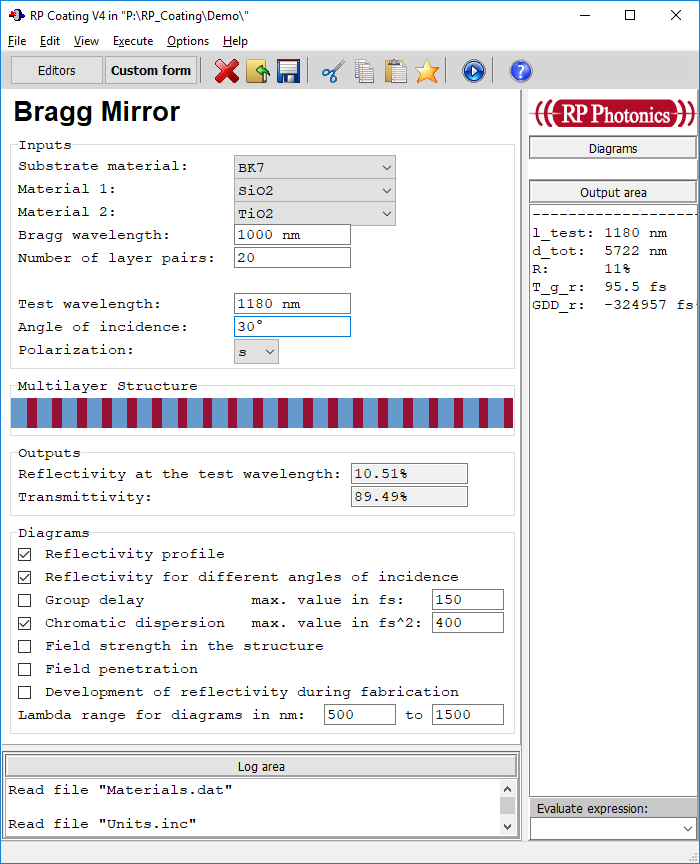Version History of the Software RP Coating (original) (raw)
RP Coating – Advanced Software for
Designing Optical Multilayer Structures
| Overview | Purpose | Model | Interface | Demos | Versions |
|---|
The software has been subject to an extensive development program over the years, which greatly expanded its capabilities as well as the quality of the user interface.
The descriptions of earlier versions are collapsed; expand them by clicking on the ⊕ tool left of the version number.
V4
Version 4 introduced various powerful and very useful tools for developing scripts:
- There are much improved script editors with highly convenient features such as syntax highlighting: recognized names of commands or functions and keywords are highlighted with different colors. Also, the software displays some things such as comments and string constants differently.
- In order to easily recall the required parameters of the many supported functions, we have introduced so-called parameter help. If you just type a function name followed by “(” into an editor, you will get the parameter help displayed; you can also later on click on a function parameter to get it.
- You can quickly call a syntax check of a script without executing it.
- You can get a script automatically reformatted according to standard rules. That way, you get consistently formatted and thus nicely readable scripts, even when you have been somewhat sloppy when writing them.
- With the new debugger you can execute scripts command by command and check the state of the system at any time. Just click the left of a line to create a breakpoint (shown in green, see the screen shot below). Similarly, you can debug expressions. This can be extremely helpful when developing sophisticated simulation scripts.
In the version history of RP Fiber Power (for V7) you find some screen shots for the same kinds of features as you get in RP Coating V4. See also the description of the user interface.
The RP Photonics Software News of 2017-07-13 also give some interesting details.
V3
Version 3 allows one to create custom forms, defined in scripts, i.e., in text form. This means that interactive forms can be made which are tailored to specific applications. The screen shot below is just an example of a custom form containing tabs and graphical controls.

Below you see part of the code used for defining the custom form. Simple but flexible commands define which variables are edited, with what units they are displayed, what are their minimum and maximum allowed values, etc.
Custom form:
--------------------------------------------------------------
$font: "Arial", bold, size = 24
Bragg Mirror
$font: "Courier New", size = 11, space = 2.1
$def pwidth := 505
$box "Inputs", size = (pwidth, 0):
Material 1: ################## <span class="katex"><span class="katex-mathml"><math xmlns="http://www.w3.org/1998/Math/MathML"><semantics><mrow><mi>i</mi><mi>n</mi><mi>p</mi><mi>u</mi><mi>t</mi><mo stretchy="false">(</mo><mi>c</mi><mi>o</mi><mi>m</mi><mi>b</mi><mi>o</mi><mi>b</mi><mi>o</mi><mi>x</mi><mo>:</mo><mi mathvariant="normal">"</mi><mi>S</mi><mi>i</mi><mi>O</mi><mn>2</mn><mi mathvariant="normal">"</mi><mo separator="true">,</mo><mi mathvariant="normal">"</mi><mi>T</mi><mi>i</mi><mi>O</mi><mn>2</mn><mi mathvariant="normal">"</mi><mo separator="true">,</mo><mi mathvariant="normal">"</mi><mi>H</mi><mi>f</mi><mi>O</mi><mn>2</mn><mi mathvariant="normal">"</mi><mo separator="true">,</mo><mi mathvariant="normal">"</mi><mi>Z</mi><mi>r</mi><mi>O</mi><mn>2</mn><mi mathvariant="normal">"</mi><mo stretchy="false">)</mo><mi>m</mi><mi>a</mi><mi>t</mi><mi>e</mi><mi>r</mi><mi>i</mi><mi>a</mi><mi>l</mi><mn>1</mn></mrow><annotation encoding="application/x-tex">input (combobox: "SiO2", "TiO2", "HfO2", "ZrO2") material1</annotation></semantics></math></span><span class="katex-html" aria-hidden="true"><span class="base"><span class="strut" style="height:1em;vertical-align:-0.25em;"></span><span class="mord mathnormal">in</span><span class="mord mathnormal">p</span><span class="mord mathnormal">u</span><span class="mord mathnormal">t</span><span class="mopen">(</span><span class="mord mathnormal">co</span><span class="mord mathnormal">mb</span><span class="mord mathnormal">o</span><span class="mord mathnormal">b</span><span class="mord mathnormal">o</span><span class="mord mathnormal">x</span><span class="mspace" style="margin-right:0.2778em;"></span><span class="mrel">:</span><span class="mspace" style="margin-right:0.2778em;"></span></span><span class="base"><span class="strut" style="height:1em;vertical-align:-0.25em;"></span><span class="mord">"</span><span class="mord mathnormal" style="margin-right:0.05764em;">S</span><span class="mord mathnormal">i</span><span class="mord mathnormal" style="margin-right:0.02778em;">O</span><span class="mord">2"</span><span class="mpunct">,</span><span class="mspace" style="margin-right:0.1667em;"></span><span class="mord">"</span><span class="mord mathnormal" style="margin-right:0.13889em;">T</span><span class="mord mathnormal">i</span><span class="mord mathnormal" style="margin-right:0.02778em;">O</span><span class="mord">2"</span><span class="mpunct">,</span><span class="mspace" style="margin-right:0.1667em;"></span><span class="mord">"</span><span class="mord mathnormal" style="margin-right:0.08125em;">H</span><span class="mord mathnormal" style="margin-right:0.10764em;">f</span><span class="mord mathnormal" style="margin-right:0.02778em;">O</span><span class="mord">2"</span><span class="mpunct">,</span><span class="mspace" style="margin-right:0.1667em;"></span><span class="mord">"</span><span class="mord mathnormal" style="margin-right:0.07153em;">Z</span><span class="mord mathnormal" style="margin-right:0.02778em;">r</span><span class="mord mathnormal" style="margin-right:0.02778em;">O</span><span class="mord">2"</span><span class="mclose">)</span><span class="mord mathnormal">ma</span><span class="mord mathnormal">t</span><span class="mord mathnormal" style="margin-right:0.02778em;">er</span><span class="mord mathnormal">ia</span><span class="mord mathnormal" style="margin-right:0.01968em;">l</span><span class="mord">1</span></span></span></span>
Material 2: ################## <span class="katex"><span class="katex-mathml"><math xmlns="http://www.w3.org/1998/Math/MathML"><semantics><mrow><mi>i</mi><mi>n</mi><mi>p</mi><mi>u</mi><mi>t</mi><mo stretchy="false">(</mo><mi>c</mi><mi>o</mi><mi>m</mi><mi>b</mi><mi>o</mi><mi>b</mi><mi>o</mi><mi>x</mi><mo>:</mo><mi mathvariant="normal">"</mi><mi>S</mi><mi>i</mi><mi>O</mi><mn>2</mn><mi mathvariant="normal">"</mi><mo separator="true">,</mo><mi mathvariant="normal">"</mi><mi>T</mi><mi>i</mi><mi>O</mi><mn>2</mn><mi mathvariant="normal">"</mi><mo separator="true">,</mo><mi mathvariant="normal">"</mi><mi>H</mi><mi>f</mi><mi>O</mi><mn>2</mn><mi mathvariant="normal">"</mi><mo separator="true">,</mo><mi mathvariant="normal">"</mi><mi>Z</mi><mi>r</mi><mi>O</mi><mn>2</mn><mi mathvariant="normal">"</mi><mo stretchy="false">)</mo><mi>m</mi><mi>a</mi><mi>t</mi><mi>e</mi><mi>r</mi><mi>i</mi><mi>a</mi><mi>l</mi><mn>2</mn></mrow><annotation encoding="application/x-tex">input (combobox: "SiO2", "TiO2", "HfO2", "ZrO2") material2</annotation></semantics></math></span><span class="katex-html" aria-hidden="true"><span class="base"><span class="strut" style="height:1em;vertical-align:-0.25em;"></span><span class="mord mathnormal">in</span><span class="mord mathnormal">p</span><span class="mord mathnormal">u</span><span class="mord mathnormal">t</span><span class="mopen">(</span><span class="mord mathnormal">co</span><span class="mord mathnormal">mb</span><span class="mord mathnormal">o</span><span class="mord mathnormal">b</span><span class="mord mathnormal">o</span><span class="mord mathnormal">x</span><span class="mspace" style="margin-right:0.2778em;"></span><span class="mrel">:</span><span class="mspace" style="margin-right:0.2778em;"></span></span><span class="base"><span class="strut" style="height:1em;vertical-align:-0.25em;"></span><span class="mord">"</span><span class="mord mathnormal" style="margin-right:0.05764em;">S</span><span class="mord mathnormal">i</span><span class="mord mathnormal" style="margin-right:0.02778em;">O</span><span class="mord">2"</span><span class="mpunct">,</span><span class="mspace" style="margin-right:0.1667em;"></span><span class="mord">"</span><span class="mord mathnormal" style="margin-right:0.13889em;">T</span><span class="mord mathnormal">i</span><span class="mord mathnormal" style="margin-right:0.02778em;">O</span><span class="mord">2"</span><span class="mpunct">,</span><span class="mspace" style="margin-right:0.1667em;"></span><span class="mord">"</span><span class="mord mathnormal" style="margin-right:0.08125em;">H</span><span class="mord mathnormal" style="margin-right:0.10764em;">f</span><span class="mord mathnormal" style="margin-right:0.02778em;">O</span><span class="mord">2"</span><span class="mpunct">,</span><span class="mspace" style="margin-right:0.1667em;"></span><span class="mord">"</span><span class="mord mathnormal" style="margin-right:0.07153em;">Z</span><span class="mord mathnormal" style="margin-right:0.02778em;">r</span><span class="mord mathnormal" style="margin-right:0.02778em;">O</span><span class="mord">2"</span><span class="mclose">)</span><span class="mord mathnormal">ma</span><span class="mord mathnormal">t</span><span class="mord mathnormal" style="margin-right:0.02778em;">er</span><span class="mord mathnormal">ia</span><span class="mord mathnormal" style="margin-right:0.01968em;">l</span><span class="mord">2</span></span></span></span>
Bragg wavelength: #############
$input l_Bragg_m:d6:"(n)m", min = 100e-9, max = 10e-6
Number of layer payers: #############
$input N_Bragg:f0, min = 0, max = 1000You can make such forms yourself, or get them made through the technical support, and then enjoy very convenient handling for your everyday work. When given such a form, anyone can very easily get certain calculations done without dealing himself or herself with the underlying script code. And if additional features are required later on, just get the form expanded accordingly.
V2
Version 2 introduced substantial improvements of the user interface.
V1
This was the original version.
If you have any further questions or need a quotation: Contact us